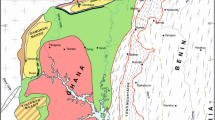Abstract
Trend analysis was made of selected variables from a unit representing two seatearth- to- seatearth cycles within the Upper Carboniferous coal measures of Ayrshire, Scotland. A positive correlation is shown between structural level and thickness of the unit at local, but not regional level, indicating that the broad structure was initiated in late or post-Carboniferous time, but that local structural features were active during deposition. Trend analysis of clastic proportions of the unit suggest a derivation of coarse material from the northeast in a postulated model of sand lobes and sheets extending down paleoslope across a platform" of mud deposition. Individual coal-thickness variations seemingly are complex and probably subject to a mixture of controls at local and regional scales.
Similar content being viewed by others
References
Allen, P., and Krumbein, W. C., 1962, Secondary trend components in the Top Ashdown pebble bed, a case history: Jour. Geology, v. 70, no. 5, p. 507–538.
Anderson, E. M., 1925, Economic geology of the Ayrshire coalfields, Area II: Geol. Survey of Great Britain Mem., 138 p.
Duff, P. McL. D., and Walton, E. K., 1964, Trend surface analysis of sedimentary features of theModiolaris zone, East Pennine coalfield, England,in Deltaic and shallow marine deposits Elsevier Publ. Co., Amsterdam, p. 114–122.
Eyles, V. A., and MacGregor, A. G., 1925, Summary of progress for 1924: Geol. Survey of Grea Britain Mem., p. 91–92.
Gilligan, A., 1920, The petrography of the Millstone Grit of Yorkshire: Geol. Soc. London Quart. v. 75, pt. 4, p. 251–294.
Goodlet, G. A., 1959, Mid-Carboniferous sedimentation in the Midland Valley of Scotland, Edin burgh Geol. Soc. Trans., v. 17, pt. 3, p. 217–240.
Holroyd-Doveton, J., 1969, Mathematical studies of coal measures sedimentation in Ayrshire Scotland: Unpubl. doctoral dissertation, Edinburgh Univ., 134 p.
Mykura, W., 1967, The Upper Carboniferous rocks of southwest Ayrshire: Geol. Survey of Grea Britain Bull., v. 26, p. 23–98.
Read, W. A., and Dean, J. M., 1967, A quantitative study of a sequence of coal-bearing cycles in the Namurian of central Scotland, 1: Sedimentology, v. 9, no. 2, p. 137–156.
Read, W. A., and Merriam, D. F., 1966, Trend-surface analysis of stratigraphic thickness data fron some Namurian rocks east of Stirling, Scotland: Scottish Jour. Geol., v. 2, pt. 1, p. 96–100.
Author information
Authors and Affiliations
Rights and permissions
About this article
Cite this article
Doveton, J.H. Trend analysis of a thin sedimentary sequence within the Upper Carboniferous of Ayrshire, Scotland. Mathematical Geology 2, 47–62 (1970). https://doi.org/10.1007/BF02332080
Received:
Issue Date:
DOI: https://doi.org/10.1007/BF02332080




